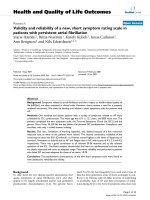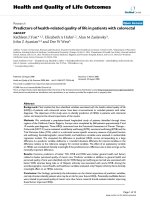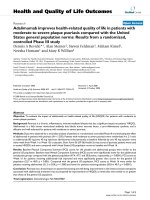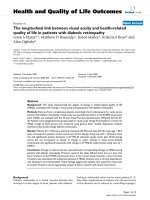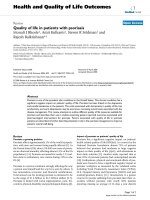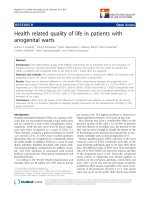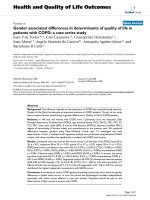A single-arm confirmatory trial of pazopanib in patients with paclitaxelpretreated primary cutaneous angiosarcoma: Japan Clinical Oncology Group study (JCOG1605, JCOG-PCAS protocol)
Bạn đang xem bản rút gọn của tài liệu. Xem và tải ngay bản đầy đủ của tài liệu tại đây (510.13 KB, 6 trang )
Oashi et al. BMC Cancer
(2020) 20:652
/>
STUDY PROTOCOL
Open Access
A single-arm confirmatory trial of
pazopanib in patients with paclitaxelpretreated primary cutaneous
angiosarcoma: Japan Clinical Oncology
Group study (JCOG1605, JCOG-PCAS
protocol)
Kohei Oashi1* , Taro Shibata2, Kenjiro Namikawa3, Akira Takahashi3, Kenji Yokota4, Eiji Nakano3, Yukiko Teramoto5,
Arata Tsutsumida6, Taku Maeda7, Naoya Yamazaki3 and the Dermatologic Oncology Group of the Japan Clinical
Oncology Group
Abstract
Background: Paclitaxel is a standard of care for patients with primary cutaneous angiosarcoma of the scalp and
face. However, no standard second-line treatment for paclitaxel-resistant patients has ever been established. Since
primary cutaneous angiosarcoma expresses a high level of vascular endothelial growth factor receptor, the
multitargeted tyrosine kinase inhibitor pazopanib seemed to be the most promising agent, and several
retrospective studies have demonstrated its activity against this disease. However, the efficacy and safety of
pazopanib in paclitaxel-resistant patients with primary cutaneous angiosarcoma have never been evaluated in a
clinical trial.
Methods: In February 2018 the Dermatologic Oncology Group of Japan Clinical Oncology Group started a singlearm confirmatory trial to evaluate the efficacy and safety of pazopanib as a second-line treatment for patients with
primary cutaneous angiosarcoma whose disease was resistant to paclitaxel or who were unable to tolerate
paclitaxel (JCOG1605, JCOG-PCAS). Patients with primary cutaneous angiosarcoma not associated with lymphedema
or radiation, progressing despite first-line paclitaxel monotherapy are included in the study. No prior systemic
chemotherapy other than paclitaxel is permitted. Pazopanib is administered orally at an initial dosage of 800 mg
once daily. Dose modifications for adverse events are made according to the dose reduction criteria described in
the protocol. Treatment is continued until recurrence, disease progression, unacceptable toxic effects, patient
refusal, or death. The primary endpoint is progression-free survival, secondary endpoints include overall survival,
(Continued on next page)
* Correspondence:
1
Department of Dermatology, Saitama Cancer Center, 780 Komuro, Ina,
Kita-adachi-gun, Saitama 362-0806, Japan
Full list of author information is available at the end of the article
© The Author(s). 2020 Open Access This article is licensed under a Creative Commons Attribution 4.0 International License,
which permits use, sharing, adaptation, distribution and reproduction in any medium or format, as long as you give
appropriate credit to the original author(s) and the source, provide a link to the Creative Commons licence, and indicate if
changes were made. The images or other third party material in this article are included in the article's Creative Commons
licence, unless indicated otherwise in a credit line to the material. If material is not included in the article's Creative Commons
licence and your intended use is not permitted by statutory regulation or exceeds the permitted use, you will need to obtain
permission directly from the copyright holder. To view a copy of this licence, visit />The Creative Commons Public Domain Dedication waiver ( applies to the
data made available in this article, unless otherwise stated in a credit line to the data.
Oashi et al. BMC Cancer
(2020) 20:652
Page 2 of 6
(Continued from previous page)
response rate, disease control rate, adverse events, and serious adverse events. We plan to recruit 30 participants in
5.5 years from 23 Japanese institutions. The follow-up period is set as 1 year after completion of accrual. The study
protocol was approved by the Japan Clinical Oncology Group Protocol Review Committee in December 2017.
Ethical approval for this study was granted by Ethics Committee of each institute.
Discussion: If the primary endpoint is met, pazopanib will be regarded as a standard of care for paclitaxel-resistant
patients for whom no standard second-line treatment is established.
Trials registration: Registry number: UMIN000031438 [ Date of Registration:
23/Feb/2018. Date of First Participant Enrollment: 8/Mar/2018.
Keywords: Angiosarcoma, Chemotherapy, Pazopanib, Single arm comfirmatory trial, Paclitaxel-resistant
Background
Angiosarcomas are extremely rare forms of sarcoma
which originate from vascular endothelial cells. The
number of patients accounts for 1 to 2% of all softtissue and visceral sarcomas [1–4]. Angiosarcomas
can be classified into five subtypes, including cutaneous angiosarcoma not associated with lymphedema (primary cutaneous angiosarcoma), cutaneous
angiosarcoma
associated
with
lymphedema,
radiation-induced cutaneous angiosarcoma, angiosarcoma of deep soft tissue, and angiosarcoma of parenchymal organs [5]. They are regarded as closely
related tumors which share similar pathological features rather than a single entity. Primary cutaneous
angiosarcoma is the most frequent subtype of angiosarcoma which accounts for about 28% of all angiosarcoma patients. Primary cutaneous angiosarcoma
typically develops in the head and neck region, especially in the scalp and upper face of elderly men.
Angiosarcoma of the head and neck region has a
poor prognosis with reported 5 year survival rates of
11 to 53% [1, 3, 4, 6–10].
The standard of care for localized cutaneous angiosarcoma in Western countries is radical surgery combined with adjuvant radiation therapy (RT) [11, 12].
Since Japanese patients tend to present with larger
primary tumors and a poorer prognosis in comparison with Caucasian patients [1, 5, 13–15], systemic
chemotherapy (adjuvant and/or neoadjuvant) in combination with local treatment can be a viable option
for Japanese patients [16].
Although doxorubicin has been a key drug in the
treatment of metastatic and unresectable soft tissue
sarcomas [17], since paclitaxel has been shown to be
more effective against primary cutaneous angiosarcoma of the scalp and face [2, 18, 19], multimodal
treatment, including local treatment and chemotherapy with paclitaxel has become a standard of care for
Japanese patients with locoregional primary cutaneous
angiosarcoma of the scalp and face. Because systemic
chemotherapy with paclitaxel is also a first-line
treatment for patients with distant metastasis, paclitaxel is administered to Japanese patients with primary cutaneous angiosarcoma as an initial treatment
regardless of the extent of their disease. However, no
standard second-line treatment for paclitaxel-resistant
patients has ever been established, and the prognosis
of such patients is dismal.
The recent development of molecular targeted therapy
for cancer has resulted in the availability of many potential drugs for the treatment of primary cutaneous angiosarcoma [20–22]. In addition to molecular targeted
therapies, several new cytotoxic agents, including eribulin and trabectedin, have shown to be effective in the
treatment of advanced sarcoma [23, 24]. Unfortunately,
these clinical trials have seldom or never included patients with primary cutaneous angiosarcoma, and thus a
new clinical trial focusing on primary cutaneous angiosarcoma alone has been needed to evaluate the efficacy
of these new drugs. Since primary cutaneous angiosarcoma expresses a high level of vascular endothelial
growth factor receptor (VEGFR) [25, 26], the multitargeted tyrosine kinase inhibitor pazopanib, which blocks
VEGFR- 1, 2, and 3, the platelet-derived growth factor
receptor (PDGFR), and c-Kit, seemed to be the most
promising agent [27], and several retrospective studies
have demonstrated its activity against this disease [28–
32]. However, the efficacy and safety of pazopanib in patients with primary cutaneous angiosarcoma have never
been evaluated in a clinical trial.
In February 2018, the Dermatologic Oncology Group
of Japan Clinical Oncology Group (JCOG) therefore
started a single-arm confirmatory trial to evaluate the efficacy and safety of pazopanib as a second-line treatment
for patients with primary cutaneous angiosarcoma whose
disease was resistant to paclitaxel or who were unable to
tolerate paclitaxel (JCOG1605, JCOG-PCAS).
Methods / design
Aim
The purpose of this study is to evaluate the efficacy
and safety of pazopanib as a second-line treatment
Oashi et al. BMC Cancer
(2020) 20:652
for patients with primary cutaneous angiosarcoma
after failure of first-line paclitaxel.
Study setting
A multi-institutional, single-arm, open-label, confirmatory trial.
Funding
This study is supported in part by the National Cancer Center Research and Development Fund of Japan
(2020-J-3).
Endpoints
The primary endpoint is progression-free survival (PFS).
PFS is defined as the time from registration to either the
first event of tumor progression or death from any
cause, and it is censored at the latest day when the patient is alive without any evidence of progression.
The secondary endpoints are overall survival (OS),
response rate (RR), disease control rate (DCR), adverse events (AEs), and serious adverse events
(SAEs). OS is defined as the time from registration
to death from any cause, and it is censored at the
last day the patient is known to be alive. RR is defined as the proportion of patients whose best overall response without confirmation is complete
response (CR) or a partial response (PR) out of patients with measurable lesion at the baseline. Patient
response is measured in accordance with the Response Evaluation Criteria in Solid Tumors, version
1.1 (RECIST 1.1). DCR is defined as the proportion
of patients whose best overall response without confirmation is CR, PR, or stable disease (SD) out of patients with measurable lesion at the baseline. AEs
are evaluated according to the Common Terminology Criteria for Adverse Events version 4.0
(CTCAE 4.0). SAE is defined as any ≧grade 4 nonhematologic toxicity at least possibly related to treatment, death from any cause during treatment or
within 30 days after the last administration, and
treatment-related death.
Inclusion criteria
1) Histologically confirmed primary cutaneous
angiosarcoma that is not associated with
lymphedema or a history of radiation exposure.
2) Primary or metastatic lesions (histological
evaluation is not essential for metastatic lesions).
3) Absence of intracranial metastasis.
4) Age between 20 years and 85 years old.
5) Eastern Cooperative Oncology Group (ECOG)
performance status of 0 or 1.
6) Past history of paclitaxel monotherapy as a first-line
treatment in combination with or not in
Page 3 of 6
combination with any local treatment (surgery and/
or radiation therapy).
7) No past history of any systemic chemotherapy
other than paclitaxel.
8) Resistance or intolerance to paclitaxel.
9) A measurable lesion is not required.
10) No prior use of antiangiogenic agents.
11) Absence of any non-healing wound.
12) Adequate organ and marrow function as defined
below within 14 days prior to enrollment:
a) Absolute neutrophil count ≧1500/mm3.
b) Hemoglobin ≧9.0 g/dL.
c) Platelet count ≧10 × 104/mm3.
d) Total bilirubin ≦2.25 mg/dL.
e) Aspartate aminotransferase ≦75 U/L.
f) Alanine aminotransferase, male: ≦105 U/L,
female: ≦57.5 U/L.
g) Renal function: serum creatinine ≦1.5 mg/dL,
or, if > 1.5 mg/dL, calculated creatinine clearance >
50 mL/min.
h) Prothrombin time-international normalized ratio
≦1.38.
i) Activated partial thromboplastin time ≦44.4 s.
j) Thyroid-stimulating hormone: 0.5–4.5 μU/mL.
k) Free triiodothyronine: 2.0–4.0 pg/mL.
l) Free thyroxine: 0.9–1.8 ng/dL.
m) Left ventricular ejection fraction ≧50%.
n) Corrected QT interval ≦480 ms.
o) Negative urinary protein, or, if not negative, 24-h
urinary protein excretion ≦0.15 g (urinary protein/
creatinine ratio ≦0.15 g/gCr is permitted).
13) Written informed consent.
Exclusion criteria
1) A synchronous or metachronous (within 3
years) malignancy except for carcinoma in situ
or intramucosal tumors curatively treated by
local therapy with a 5-year survival of over
95%.
2) Active infection requiring systemic therapy.
3) Body temperature ≧38 degrees Celsius.
4) Pregnant, possibly pregnant, or lactating women.
Within 28 days after childbirth. Men favoring
gestation of their partners.
5) Severe psychiatric disease.
6) Current systemic administration of a steroid or
other immunosuppressant.
7) Hypertension (> 140 mmHg systolic and > 90 mmHg
diastolic) that cannot be adequately controlled with
antihypertensive treatments.
8) Any cardiovascular disease or procedure listed
below within 6 months prior to enrollment:
a) Percutaneous transluminal coronary angioplasty.
b) Myocardial infarction.
Oashi et al. BMC Cancer
(2020) 20:652
c) Unstable angina pectoris.
d) Coronary artery bypass grafting.
e) Symptomatic peripheral arterial disease.
f) New York Heart Association class III or IV heart
failure.
9) Massive pleural or pericardial effusion.
10) Interstitial lung disease.
11) Intestinal paralysis or ileus.
12) Active bleeding.
13) Cerebrovascular event within 6 months prior to
enrollment.
14) Pulmonary embolism within 6 months prior to
enrollment.
15) Untreated deep vein thrombosis within 6 months
prior to enrollment.
Treatment
Pazopanib is administered orally at an initial dosage of
800 mg once daily. Dose modifications for adverse events
including hypertension, hepatic disorders, and cardiac
dysfunction are made in accordance with the dose reduction criteria. Treatment is continued until recurrence, disease progression (according to RECIST version
1.1), unacceptable toxic effects, and withdrawal of consent or death.
Follow-up
All patients will be followed up for at least 1 year after
patient accrual is completed. Enhanced cervical, thoracic, abdominal and pelvic computed tomography (CT)
images will be evaluated at least every 4 weeks until disease progression or death. Tumor response will also be
assessed every 4 weeks according to RECIST version 1.1.
Physical examination, laboratory tests, and evaluation of
adverse events according to CTCAE ver. 4.0 will be carried out at least every 2 weeks during protocol
treatment.
Statistical analysis
This study is designed as a single-arm, confirmatory
study to confirm the efficacy and safety of pazopanib as
a second-line treatment in patients with primary cutaneous angiosarcoma that has become resistant or in patients who have become intolerant to paclitaxel. The
planned sample size is 30, which will provide 70% power
under the hypothesis of the median PFS being the expected value of 5.0 months and a threshold value of 3.0
months using a one-sided alpha of 0.1.
Interim analysis and monitoring
We plan to conduct futility analyses to judge whether
the study should be terminated early due to futility. The
futility analyses will be conducted after half of the
Page 4 of 6
planned number patients have been enrolled. If the
upper limit of the 95% confidence interval (CI) of the
median PFS is less than the expected value, a decision
on the study termination will be made via a comprehensive review at that time. The JCOG Data Center staff
and the Study Coordinator will conduct central monitoring issuing a monitoring report at least every 1 year to
evaluate and improve study progress, data integrity and
patient safety. Futility will be considered at each monitoring report if necessary. For quality assurance, sitevisit audits, not for a study-specific basis but for the
study group basis, will be performed by the JCOG Audit
Committee.
Discussion
The aim of this study is to evaluate the efficacy and
safety of pazopanib as a second-line treatment for patients with primary cutaneous angiosarcoma after failure of first-line paclitaxel. If the primary endpoint is
met, pazopanib will be regarded as a standard of care
for paclitaxel-resistant patients for whom no standard
second-line treatment is established. This study is designed as a single arm trial considering rarity of disease. Given the fact that expected and threshold value
of primary endpoint was set according to robust historical control data (unpublished), we position this
study as a confirmatory trial.
Abbreviations
RT: Radiation therapy; VEGFR: Vascular endothelial growth factor receptor;
PDGFR: Platelet-derived growth factor receptor; JCOG: Japan Clinical
Oncology Group; PFS: Progression-free survival; OS: Overall survival;
RR: Response rate; DCR: Disease control rate; AEs: Adverse events;
SAEs: Serious adverse events; CR: Complete response; PR: Partial response;
RECIST: Response Evaluation Criteria in Solid Tumors; CTCAE: Common
Terminology Criteria for Adverse Events; ECOG: Eastern Cooperative
Oncology Group; JCOG: The Japan Clinical Oncology Group; CI: Confidence
interval; CT: Computed tomography
Acknowledgements
We would like to thank the all members of JCOG Data Center/Operation
office and JCOG Dermatologic Oncology Group.
Authors’ contributions
KO, as a corresponding author, proposed the concept and idea for
JCOG1605 study, drafted the protocol design of the study and wrote the
manuscript. TS contributed to the design and logistics of the protocol, proofread the manuscript, and will undertake statistical analysis. KN, AT, KY, EN, YT,
AT and TM were in charge of registering the trial protocol to the review
boards of each participating institution and proof-read the manuscript. NY
proposed the concept and idea for JCOG1605, contributed to the design
and logistics of the protocol and proof-read the manuscript, and conducted
the initiation of the study. All authors critically revised the manuscript for intellectual content and approved the final manuscript.
Funding
This study was supported in part by the National Cancer Center Research
and Development Fund of Japan (2020-J-3). The role of the funders is to
provide financial support for management office, aid in the development of
the electronic data capturing system, and to conduct meetings. The National
Cancer Center Research and Development peer reviewed the study protocol
and monitored research progress.
Oashi et al. BMC Cancer
(2020) 20:652
Availability of data and materials
Data sharing is not applicable to this article as no datasets were generated
or analysed at the time of submission.
Ethics approval and consent to participate
This study is being conducted in accordance with the principles expressed in
the Declaration of Helsinki, Japanese Ethical Guidelines for Medical and
Health Research Involving Human Subjects and SPIRIT (Standard Protocol
Items: Recommendations for Interventional Trials) guidelines. The study
protocol was approved by the JCOG Protocol Review Committee in
December 2017 and by the Institutional Review Board of National Cancer
Center Hospital on February 9th, 2018. Written informed consent has been
obtained from all enrolled participants. At the time of submission (June
2020), a total of 21 institutions are participating in this trial. The participating
institutions are as follows: Hokkaido University Hospital, Asahikawa Medical
University Hospital, Sapporo Medical University School of Medicine,
University of Tsukuba, Saitama Medical University International Medical
Center, Saitama Medical University, National Cancer Center Hospital, Tokyo
Metropolitan Cancer and Infectious Disease Center Komagome Hospital, Keio
University Hospital, The University of Tokyo Hospital, Niigata Cancer Center
Hospital, Toyama Prefectural Central Hospital, Shinshu University School of
Medicine, Shizuoka Cancer Center, Nagoya University School of Medicine,
Kyoto University Hospital, Osaka International Cancer Institute, Faculty of
Medicine, Fukuoka University, Kyushu University Hospital, Kumamoto
University Hospital and National Hospital Organization Kagoshima Medical
Center.
Page 5 of 6
4.
5.
6.
7.
8.
9.
10.
11.
12.
13.
14.
Consent for publication
Not applicable.
15.
Competing interests
Dr. Namikawa has received honoraria from Ono Pharmaceutical, Bristol-Myers
Squibb, Merck Sharp & Dohme, Novartis Pharmaceutical, Toray Industries,
Takara Bio, Eisai, and Chugai Pharmaceutical, unrelated to the submitted
work.
Dr. Tsutsumida has received honoraria from Ono Pharmaceutical, BristolMyers Squibb, Merck Sharp & Dohme, Novartis Pharmaceutical, unrelated to
the submitted work.
Dr. Takahashi has received honoraria from Ono Pharmaceutical, Bristol-Myers
Squibb, Merck Sharp & Dohme, and Novartis Pharmaceutical, unrelated to
the submitted work.
Dr. Yamazaki has received honoraria from Ono Pharmaceutical, Bristol-Myers
Squibb, Merck Sharp & Dohme, Novartis Pharmaceutical, Takeda Pharmaceutical, and Chugai Pharmaceutical, unrelated to the submitted work.
Author details
1
Department of Dermatology, Saitama Cancer Center, 780 Komuro, Ina,
Kita-adachi-gun, Saitama 362-0806, Japan. 2JCOG Data Center/Operations
Office, National Cancer Center Hospital, Tokyo, Japan. 3Department of
Dermatologic Oncology, National Cancer Center Hospital, 5-1-1 Tsukiji,
Chuo-ku, Tokyo 104-0045, Japan. 4Department of Dermatology, Nagoya
University Graduate School of Medicine, Nagoya, Japan. 5Department of Skin
Oncology/Dermatology, Saitama Medical University International Medical
Center, Saitama, Japan. 6Department of Dermatologic Oncology,
Dermatology, Cancer Institute Hospital, Tokyo, Japan. 7Department of Plastic
and Reconstructive Surgery, Faculty of Medicine and Graduate School of
Medicine Hokkaido University, Sapporo, Japan.
16.
17.
18.
19.
20.
21.
22.
23.
Received: 3 June 2020 Accepted: 2 July 2020
References
1. Holden CA, Spittle MF, Jones EW. Angiosarcoma of the face and scalp,
prognosis and treatment. Cancer. 1987;59(5):1046–57.
2. Fata F, O'Reilly E, Ilson D, Pfister D, Leffel D, Kelsen DP, et al. Paclitaxel in the
treatment of patients with angiosarcoma of the scalp or face. Cancer. 1999;
86(10):2034–7.
3. Fury MG, Antonescu CR, Van Zee KJ, Brennan MF, Maki RG. A 14-year
retrospective review of angiosarcoma: clinical characteristics, prognostic
factors, and treatment outcomes with surgery and chemotherapy. Cancer J.
2005;11(3):241–7.
24.
25.
26.
Goldblum JR, Folpe AL, Weiss SW, Enzinger FM. Enzinger and Weiss’s soft
tissue tumors. 6th ed. Philadelphia: Saunders/Elsevier; 2014.
Oashi K, Namikawa K, Tsutsumida A, Takahashi A, Itami J, Igaki H, et al.
Surgery with curative intent is associated with prolonged survival in
patients with cutaneous angiosarcoma of the scalp and face -a
retrospective study of 38 untreated cases in the Japanese population. Eur J
Surg Oncol. 2018;44(6):823.
Mark RJ, Poen JC, Tran LM, Fu YS, Juillard GF. Angiosarcoma. A report of 67
patients and a review of the literature. Cancer. 1996;77(11):2400–6.
Lahat G, Dhuka AR, Hallevi H, Xiao L, Zou C, Smith KD, et al. Angiosarcoma:
clinical and molecular insights. Ann Surg. 2010;251(6):1098–106.
Lydiatt WM, Shaha AR, Shah JP. Angiosarcoma of the head and neck. Am J
Surg. 1994;168(5):451–4.
Dettenborn T, Wermker K, Schulze HJ, Klein M, Schwipper V, Hallermann C.
Prognostic features in angiosarcoma of the head and neck: a retrospective
monocenter study. J Craniomaxillofac Surg. 2014;42(8):1623–8.
Shin JY, Roh SG, Lee NH, Yang KM. Predisposing factors for poor prognosis
of angiosarcoma of the scalp and face: systematic review and meta-analysis.
Head Neck. 2017;39(2):380–6.
Penel N, Lansiaux A, Adenis A. Angiosarcomas and taxanes. Curr Treat
Options in Oncol. 2007;8(6):428–34.
Young RJ, Brown NJ, Reed MW, Hughes D, Woll PJ. Angiosarcoma. Lancet
Oncol. 2010;11(10):983–91.
Pawlik TM, Paulino AF, McGinn CJ, Baker LH, Cohen DS, Morris JS, et al.
Cutaneous angiosarcoma of the scalp: a multidisciplinary approach. Cancer.
2003;98(8):1716–26.
Morgan MB, Swann M, Somach S, Eng W, Smoller B. Cutaneous
angiosarcoma: a case series with prognostic correlation. J Am Acad
Dermatol. 2004;50(6):867–74.
Trofymenko O, Curiel-Lewandrowski C. Surgical treatment associated with
improved survival in patients with cutaneous angiosarcoma. J Eur Acad
Dermatol Venereol. 2018;32(1):e29–31.
Fujisawa Y, Yoshino K, Fujimura T, Nakamura Y, Okiyama N, Ishitsuka Y, et al.
Cutaneous Angiosarcoma: the possibility of new treatment options
especially for patients with large primary tumor. Front Oncol. 2018;8:46.
Tap W, Jones R, Van Tine B, Chmielowski B, Elias A, Adkins D, et al.
Olaratumab and doxorubicin versus doxorubicin alone for treatment of softtissue sarcoma: an open-label phase 1b and randomised phase 2 trial.
Lancet. 2016;388(10043):488–97.
Penel N, Bui BN, Bay JO, Cupissol D, Ray-Coquard I, Piperno-Neumann S,
et al. Phase II trial of weekly paclitaxel for unresectable angiosarcoma: the
ANGIOTAX study. J Clin Oncol. 2008;26(32):5269–74.
Schlemmer M, Reichardt P, Verweij J, Hartmann JT, Judson I, Thyss A, et al.
Paclitaxel in patients with advanced angiosarcomas of soft tissue: a
retrospective study of the EORTC soft tissue and bone sarcoma group. Eur J
Cancer. 2008;44(16):2433–6.
Agulnik M, Yarber JL, Okuno SH, von Mehren M, Jovanovic BD, Brockstein
BE, et al. An open-label, multicenter, phase II study of bevacizumab for the
treatment of angiosarcoma and epithelioid hemangioendotheliomas. Ann
Oncol. 2013;24(1):257–63.
Ray-Coquard I, Italiano A, Bompas E, Le Cesne A, Robin YM, Chevreau
C, et al. Sorafenib for patients with advanced angiosarcoma: a phase II
trial from the French sarcoma group (GSF/GETO). Oncologist. 2012;17(2):
260–6.
Koontz BF, Miles EF, Rubio MA, Madden JF, Fisher SR, Scher RL, et al.
Preoperative radiotherapy and bevacizumab for angiosarcoma of the head
and neck: two case studies. Head Neck. 2008;30(2):262–6.
Schöffski P, Chawla S, Maki R, Italiano A, Gelderblom H, Choy E, et al.
Eribulin versus dacarbazine in previously treated patients with advanced
liposarcoma or leiomyosarcoma: a randomised, open-label, multicentre,
phase 3 trial. Lancet (British edition). 2016;387(10028):1629–37.
Hensley M, Patel S, von Mehren M, Ganjoo K, Jones R, Staddon A, et al.
Efficacy and safety of trabectedin or dacarbazine in patients with advanced
uterine leiomyosarcoma after failure of anthracycline-based chemotherapy:
subgroup analysis of a phase 3, randomized clinical trial. Gynecol Oncol.
2017;146(3):531–7.
Itakura E, Yamamoto H, Oda Y, Tsuneyoshi M. Detection and
characterization of vascular endothelial growth factors and their receptors
in a series of angiosarcomas. J Surg Oncol. 2008;97(1):74–81.
Yonemori K, Tsuta K, Ando M, Hirakawa A, Hatanaka Y, Matsuno Y, et al.
Contrasting prognostic implications of platelet-derived growth factor
Oashi et al. BMC Cancer
27.
28.
29.
30.
31.
32.
(2020) 20:652
receptor-beta and vascular endothelial growth factor receptor-2 in patients
with angiosarcoma. Ann Surg Oncol. 2011;18(10):2841–50.
van der Graaf WT, Blay JY, Chawla SP, Kim DW, Bui-Nguyen B, Casali PG, et al.
Pazopanib for metastatic soft-tissue sarcoma (PALETTE): a randomised, doubleblind, placebo-controlled phase 3 trial. Lancet. 2012;379(9829):1879–86.
Tomita H, Koike Y, Asai M, Ogawa F, Abe K, Tanioka M, et al. Angiosarcoma
of the scalp successfully treated with pazopanib. J Am Acad Dermatol. 2014;
70(1):e19–21.
Kitamura S, Hata H, Imafuku K, Haga N, Homma E, Shimizu H. Pazopanib can
preserve cosmetic quality of life even in end-stage angiosarcoma. Clin Exp
Dermatol. 2015;40(8):931–3.
Fujiwara S, Nagai H, Nakamachi Y, Kawano S, Nishigori C. Refractory
metastasis of cutaneous angiosarcoma showing complete response to
pazopanib. Eur J Dermatol. 2015;25(1):71–3.
Miura H, Shirai H. Low-dose administration of oral pazopanib for the
treatment of recurrent angiosarcoma. Clin Exp Dermatol. 2015;40(5):575–7.
Ogata D, Yanagisawa H, Suzuki K, Oashi K, Yamazaki N, Tsuchida T.
Pazopanib treatment slows progression and stabilizes disease in patients
with taxane-resistant cutaneous angiosarcoma. Med Oncol. 2016;33(10):116.
Publisher’s Note
Springer Nature remains neutral with regard to jurisdictional claims in
published maps and institutional affiliations.
Page 6 of 6
